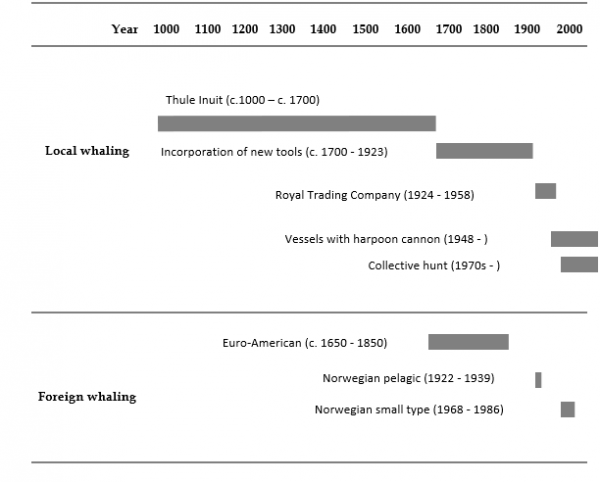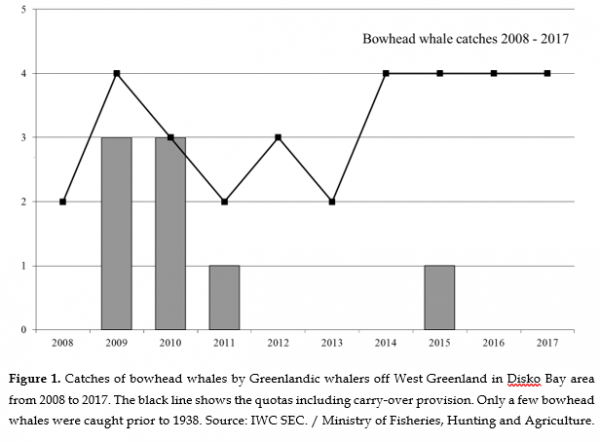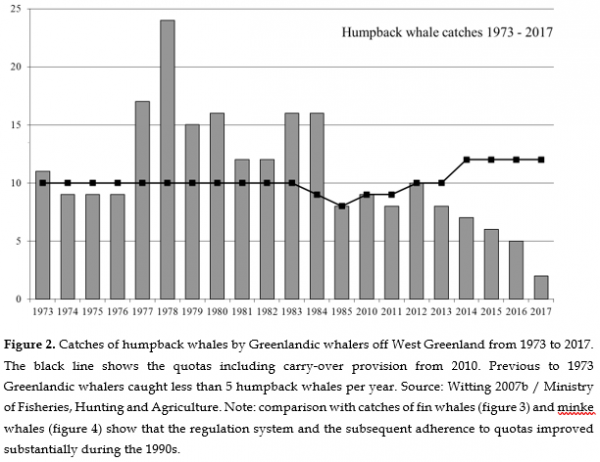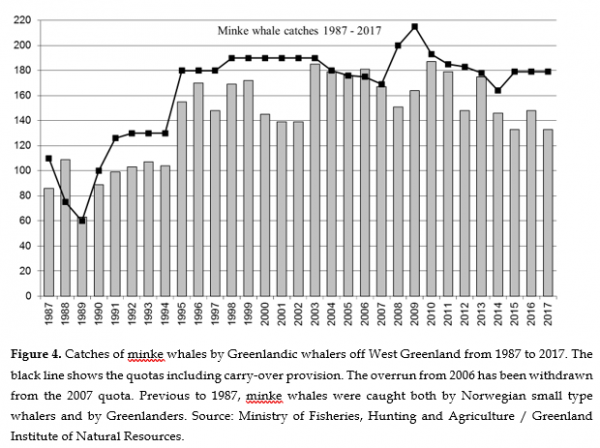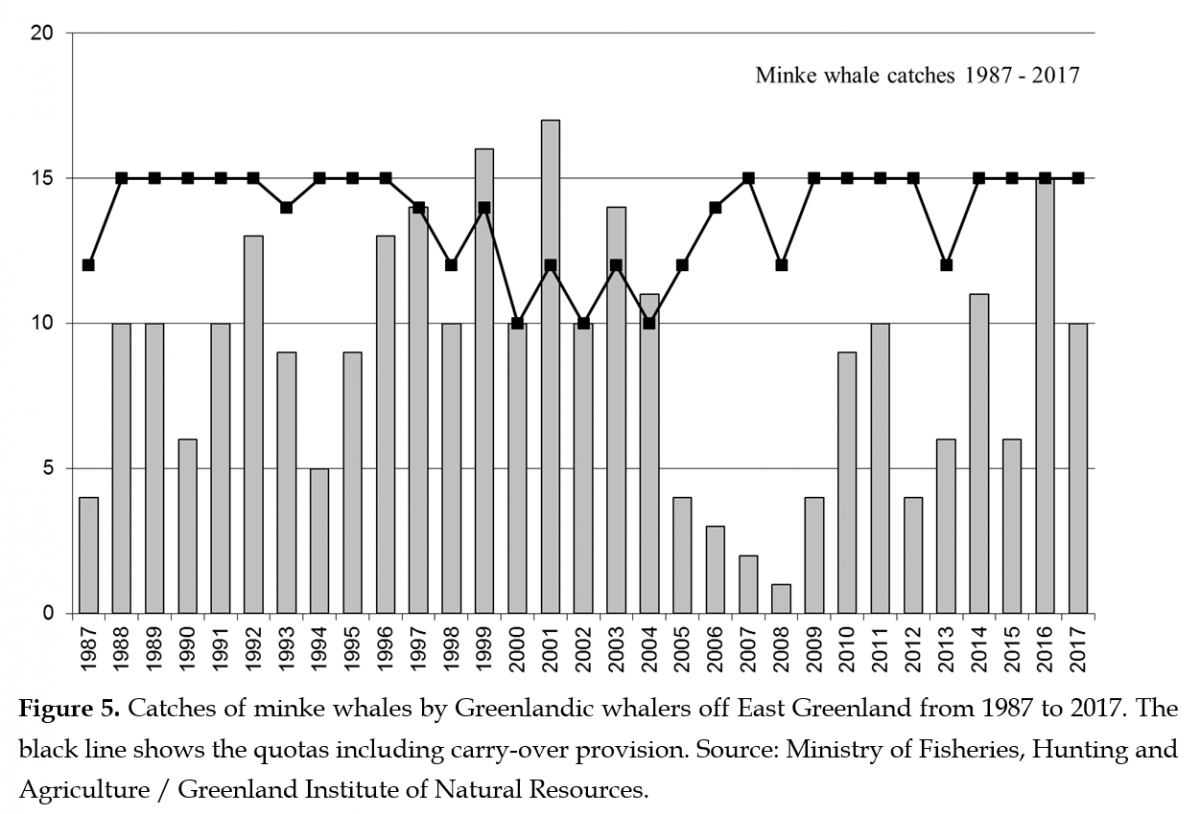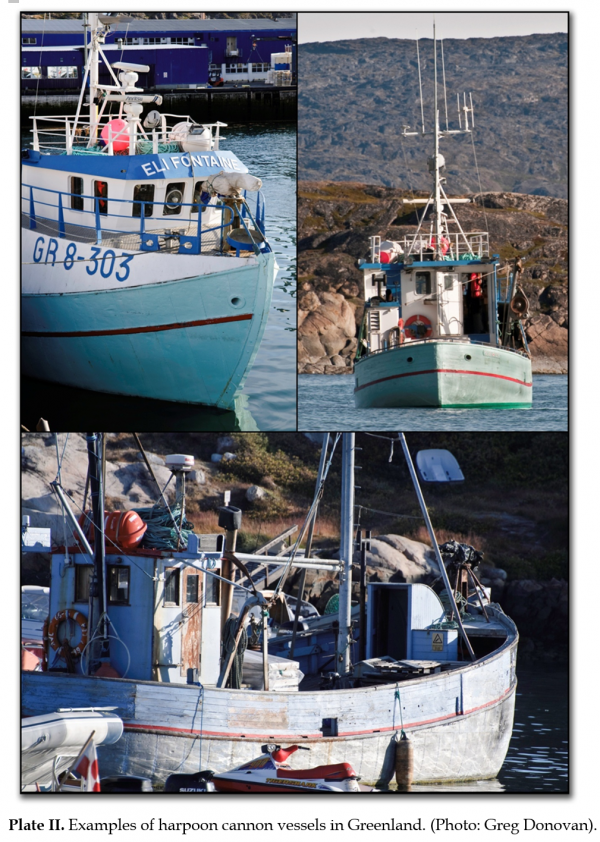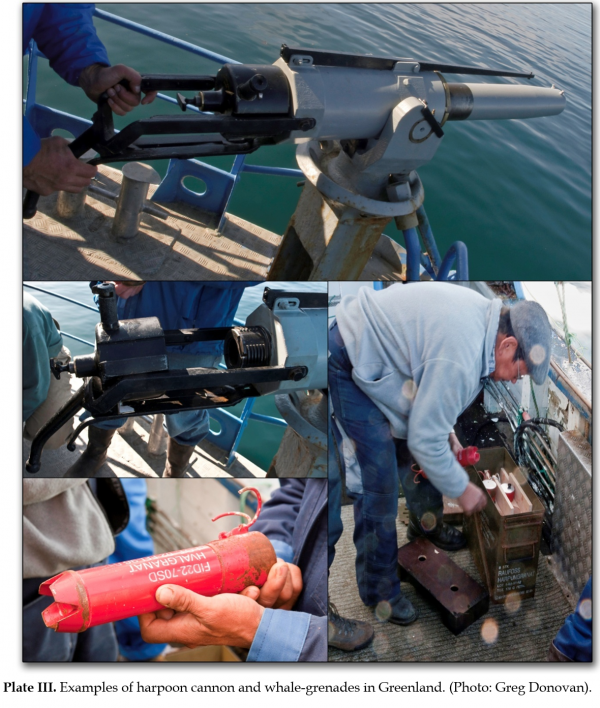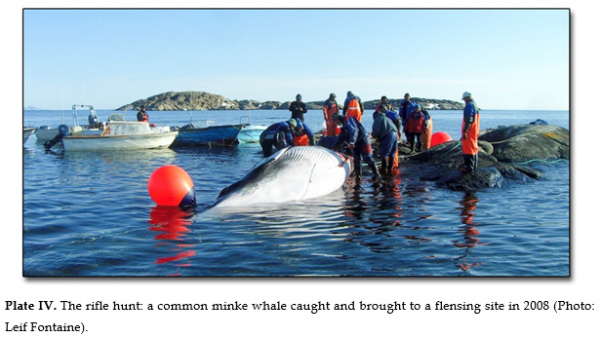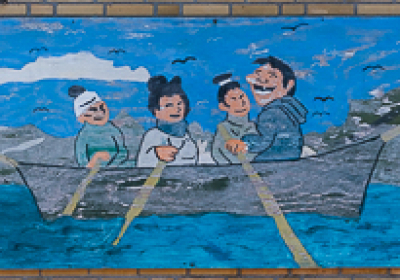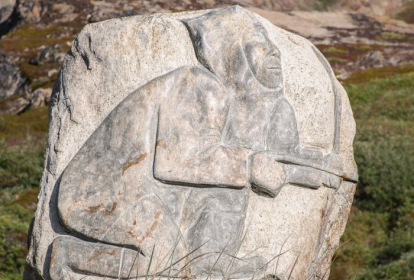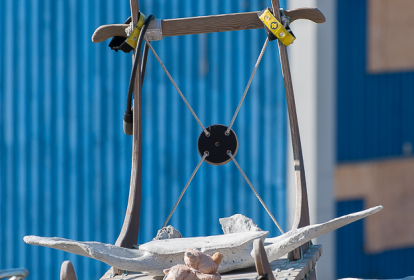1. Introduction
The most recent document providing full details of hunting off Greenland is the White Paper On Management and Utilization Of Large Whales In Greenland.
Below is a concise summary of that document.
In June 2009, Kalaallit Nunaat/Greenland obtained status as a Self-Governing part of the Kingdom of Denmark with full legislative and executive responsibility in a substantial number of fields (responsibility for the management of natural living resources was obtained on 1 January 1985). Foreign Policy remains the responsibility of the Danish Government, including international organisation of which the Kingdom of Denmark is a member, in consultation with Greenland.
Greenlanders live in a wild and harsh environment where agriculture is severely limited.
They maintain a lifestyle largely connected to the sea and dependent on marine resources, including subsistence hunting. Greenland (2018) has a population of app. 55,900 people living in 17 towns and 81 settlements (West Greenland: 52,635 and East Greenland: 3,242). Inuit comprise about 90% of the population.

The hunting of large whales is a vital component of everyday life and culture in Greenland today (as archaeological investigations have shown it was in old Greenlandic cultures). It is an important component of food security, providing nutritious food and income to families. Baleen whales are important species, and hunted in every part of Greenland during the year. The skin/mattak, lower jaw meat and ventral groves/qiporaq are a delicacy and the meat is used for celebration and for everyday food. Whale products are a vital source of proteins and omega-3 fatty acids. Baleen plates are used in craft and design. Thus, consumption of whale products has huge advantages for the environment, for the health of Kalaallit/Greenlanders in Greenland and as food security.
Through this traditional way of life over many generations, the Inuit have developed an in-depth knowledge of the ecosystems in which they live as an essential factor in survival. Traditional knowledge became fine-tuned through direct experience of a subsistence lifestyle grounded in respect for wild animals and the need to preserve wildlife resources for future generations.
Among the problems the Inuit presently face are the lack of understanding of the Arctic way of life, resulting in e.g. international trade bans, the perception that the use of money and development of the hunting activities and equipment conflicts with the status of the Inuit hunt or the rights of hunters and Indigenous peoples and the on-going climate changes in the Arctic regions. Weather and ice conditions are changing and attempts are made at both local and national level to adapt to what seems to be severe and lasting changes in the Arctic environment.
In conclusion, Greenlanders consider whaling and Greenland inseparable. With other forms of hunting and fishing, it plays a vital role in Greenlandic life, contributing to food security, health and community identity in an environmentally responsible manner.
2. Recent Catches by Greenland
Some kind of whaling has occurred in Greenland since at least the year 1000 (see the Table below). This section focusses on recent catches. More information on history can be found in Section 3 below on History, Culture and Nutrition.
Table 1. Schematic representation of different periods in the history of whaling in Greenland. Local whaling: whaling by Greenlanders or Danish for the benefit of Greenlanders. Foreign whaling: whaling off Greenland by Europeans or North Americans for the purpose of trading with oil and other whale products.
The Greenlandic hunt is traditionally a multispecies hunt. Annual catches vary due to a number of factors outside the catch limits, including hunting methods, environmental conditions and the seasonal availability and distribution of the whales. Catch/strike limits are based upon scientific advice and the most recent advice can be found in Section 5 below, on scientific advice.
After each catch, the hunter must deliver a catch report to the municipal authorities. The report is designed to collect the information described in the IWC Schedule. It includes operational information about the hunt (license, boat, method, grenade serial number) and specific catch data (e.g. place of capture, size of the animal, sex, reproductive state of females, stomach contents, weight of meat products). This is a self-reporting system. Not all hunters are able to provide information on all items included in the catch report e.g. hunters without access to a GPS write the local name of the place where the whale was hunted.
The Ministry of Fisheries, Hunting and Agriculture uses the catch reports to monitor the hunt and to provide information requested by the IWC and /or NAMMCO.
Bowhead whales, West Greenland
The taking of bowhead whales was stopped in 1938 by a decision of the Government of Denmark in order to protect the stock due to low stock numbers. In 2007, Greenland was given a quota of 2 bowhead whales per year by the IWC with the possibility of carrying over up to 2 whales from one year to the next. Greenland started the bowhead whale hunt in spring of 2009 and the first two landings were given to the Greenlandic people in connection with the introduction of Self-Government.
The average catch has been 1 bowhead whale per year with quotas remaining stable at 2 since 2007. Utilization in the quota block 2008-2012 was 50 % and in the quota block 2013-2017 6 %.
Humpback whales, West Greenland
In 1955, the IWC limited the taking of humpback whales in West Greenland to 10 animals per year. Quotas were reduced to 9 humpback whales per year in 1984 and to 8 in 1985. The IWC prohibited the catching of humpback whales off Greenland in 1986, due to uncertainties about the size of the stock. In 2010, Greenland was given a quota of 9 humpback whales per year, with the possibility of carrying over up to 2 whales from one year to the next. In the following quota block it was raised to 10 humpback whales per year based on the advice from the Scientific Committee.
The average catch has been 7 humpback whales per year since 2010. Utilization in the quota block 2008-2012 was 100 % and in the quota block 2013-2017 56 %.
Fin whales, West Greenland
During the 1960s and 1970s, Greenlanders caught 0-13 fin whales per year. Catches have been regulated by IWC aboriginal subsistence quotas since 1977, where a quota was given as a substitute for the humpback whale quota, even though it was not a traditionally target species. The quotas have remained stable at 19 since 1955.
As a result of an unsuccessful survey in 2004 to update abundance estimates, the Greenland Home Rule voluntarily reduced the quotas for 2006 and 2007 to 10 fin whales per year. The following year the survey went well and for the quota block 2008-2012 Greenland was again 19 fin whales per year.
In connection to a political decision during the 2010 IWC Annual Meeting, the Government of Greenland agreed to reduce the quota from 19 to 16 and on a voluntarily basis further reduced the catch limit from 16 to 10 from 2010 to 2012. For the present quota block the quota was again set at 19 animals based on the advice from the Scientific Committee.
The average catch has been 11 fin whales per year. Utilization in the last two quota blocks has remained stable at around 50%.
Common minke whales, West Greenland
In 1968, small type whaling boats from Norway expanded their operation to include waters of East and West Greenland. During the early and mid-1970s, Norwegian catches off West Greenland averaged 175 minke whales per year. At that time, Greenlanders caught an average of 225 minke whales per year. After 1977, following recommendations by the IWC, the Norwegian catches were reduced to 75 minke whales per year and ceased in 1986 due to the IWC moratorium.
Since 1975, catches have been regulated by IWC aboriginal subsistence quotas. Until 1985, the quotas were higher than the average catches. Since 1986, the quotas for West Greenland have ranged from 60 to 200 minke whales per year, and remained stable at around 175 whales per year since 1998 (with the exception of 2008-2009 having a quota of 200), with the possibility of carrying over up to 15 whales from one year.
The average catch has been 144 minke whales per year with quotas remaining stable at 164 since 2014. Utilization in the last two quota blocks has remained stable at around 85%.
Common minke whales, East Greenland
The quota for East Greenland has since 1986 been set at 12 minke whales per year, with the possibility of carrying over up to 3 whales from one year to the next.
The average catch has been 9 minke whales per year since from 1987. Utilization in the quota block 2008-2012 was 39 %, increasing to 67% in the quota block 2013-2017.
3. Greenland hunts for large whales: history, culture and nutrition
History
Whaling has been part of the Greenlandic culture for over a thousand years. The Thule Inuit caught bowhead and humpback whales. They used special whaling tools including the umiaq skin boat, harpoons made of whalebone, floats, hunting lines and the atallaaq dry suit made from sealskin. Contact with European and North American whalers in the 18th century resulted in changes of equipment, such as shifting to metal harpoons, more efficient flensing tools and wooden boats. Cultures naturally change with time and techniques improve. Unfortunately, up to the middle of the 20th century, exploitation by European and American whalers led to declines in several species off Greenland. Improved conservation and management of whaling mean that Greenlandic hunts that meet the Greenlanders need in a sustainable way are now possible.
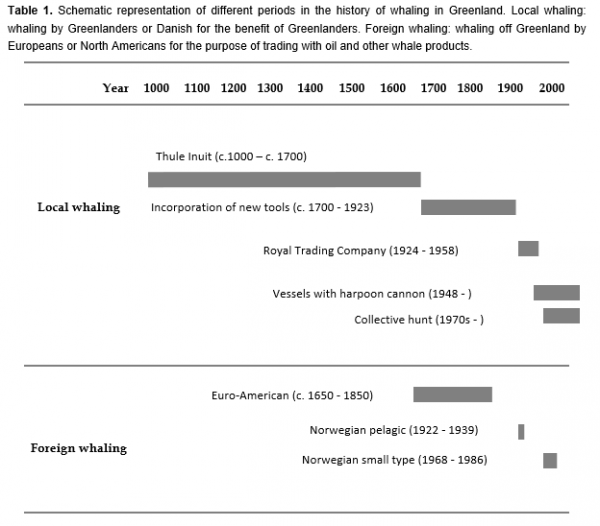
The Government of Greenland is the politically responsible organization for defining the needs of the people in Greenland, both in general and in relation to whales subject to IWC management rules. The Government in close cooperation with the municipalities is the only organization having sufficient knowledge to determine such “needs” and ensure food security. The political decisions in Greenland are based on scientific knowledge and will have to take account of the changing size of the population living in West and East Greenland.
A number of important factors must be taken into account when discussing need. These include:
- The great variability in the catch of all animals during any one given year (due to climatic variations or variations in the size of the individual groups of animals).
- The substitution possible and often necessary between the various prey animals.
- The opportunistic nature of the hunt.
- The nutritional superiority of traditional Greenlandic diet.
- Food security
Culture and distribution
Hunting whales and consuming whale products remains an important component of cultural identity in Greenland and is part of modern life today. However, Greenland is also a traditional hunting society, where food is gathered by those who are able to do it. Opportunities for employment in Greenland and especially in its settlements are limited. For many people the hunting and sharing of food resources offers the only opportunity for local food. Hunting is opportunistic, given the resources available, as different species migrate past settlements. These resources are shared throughout Greenland (there is no export of whale products). Different hunting (see Section 4 below) and distribution methods may occur in different parts of Greenland but all play an important part in community life.
The distribution and sharing of whale meat within a community, is based on an assumption of reciprocity or 'mutual insurance'. Successful hunters shared their meat recognising that they would receive a meat gift later. When sharing with neighbouring communities the barter economy prevailed. Sharing with more distant communities only became possible when organised transport was introduced.
Thus the distribution of meat is a significant and important factor in modern Greenland. Meat from the collective rifle hunt is distributed in the village, primarily amongst those participating in the hunt and their families. Only a small part (if any) is sold at local markets depending on the hunters need for money to maintain gear and cover expenses. The catches from the harpoon cannon hunt are primarily distributed locally, first and foremost to the members of the crew, to family members and friends. Most hunters sell some of their catch in the open local markets, but sometimes the meat is sold directly to community institutions such as hospitals and nursing homes to ensure that the people in these institutions can get fresh meat and eat traditional food. Some meat may be sold to authorised local stores. Finally, some meat may be sold to the processing plants in Maniitsoq or Ilulissat to ensure that some meat can be distributed to villages with limited or no possibility to hunt large whales. The plants are only allowed to process, pack and transport whale meat, in accordance with veterinary regulations, to other places along the coast. The prices of products at the open air market are fixed prices agreed by local hunters and the municipality. The amount of the earned income is reported to the municipal tax authority. The sale and distribution of edible products provides necessary income for the individual hunter and the community.
Money is an essential part of any modern society and its use does not negate indigenous people's rights or status. The cash enables hunters to buy and replenish hunting equipment, fuel and other costs to continue subsistence whaling and buy meat and other products from other towns. This has been the way in Greenland for many generations. It is how Greenlanders live and are able to share, given that Greenland is a large island with an enormous coastline, scattered villages and little infrastructure. Whale hunting and meat distribution does not follow the strategy of a commercial enterprise aiming for profit maximisation. The cash income is necessary to enable the hunting and distribution system to function and the use of improved killing methods. As an example, large whales must be hunted using an explosive whale-grenade – the cost of shooting a single grenade is (2018) approximately USD 1200 and some whales require multiple grenades, due to a requirement to keep an extra explosive whale-grenade ready.
It has been argued by some that the Greenland hunt is “commercial” or “semi-commercial”. This is clearly not the case as explained above.
It is correct that a very limited sale of whale meat takes place in local restaurants in Greenland accessible to the Greenlandic population as well as people visiting Greenland. In a review by the authorities, it was concluded that in the years prior (2010-2012) to IWC-64 when an accusation was made that sale in restaurants was disproportionate to the whales caught, an estimated average of 13 restaurant meals per day through out Greenland contained whale products (approximately 1,600 kg of whale meat per year). Given that the vast majority of visitors to restaurants are members of the Greenlandic population, the consumption by foreign tourists are considered to be insignificant. The small number of restaurant meals consumed probably reflects the fact that most local people prefer to prepare and cook the whale products in their own home in the traditional way. The few hotels and restaurants which have whale products on their menu prepare the dish in a non-traditional way.
Nutrition
The products from indigenous hunting intend to meet both immediate nutritional requirements and to provide food for the winter period as well as satisfying important cultural and socioeconomic needs. For details please see the Greenland White Paper Appendix II, paper 1-9, accessible via the IWC Meeting Portal.
In addition to the important cultural component of whaling, consuming whale meat has advantages for Greenlanders in terms of health. Several studies have confirmed the nutritional value of marine mammal products compared to imported and westernised food such as chicken, beef and pork. Whale mattak contains rich sources of vitamin A and C, thiamine, riboflavin and niacin. These are known to provide excellent protection against scurvy. Whale meat and blubber also have high concentrations of selenium. Marine mammal lipids are low in saturated fats and high in the omega-3 polyunsaturated fatty acids that give protection from the cardiovascular diseases common in North America and Europe.
There is evidence that the Inuit traditional diet protects against several diseases, including some types of cancer, thrombosis and atherosclerosis. There is also evidence that Greenlanders depend on traditional food to obtain vitamin D. The Board of Nutrition in Greenland recommends Greenlanders not to stop eating traditional food because the effects of stopping these are unknown. A reduction of traditional diet would lead to an increase in the number of western diseases.
Need in terms of edible products
The reasons for whaling being important for Greenlanders include:
- Whales and whaling are fundamental part of the culture and the history
- Large whales are a substantial source of food for a great part of the population
- The selling, sharing and distribution of whale meat provides a necessary source of food security and income for many people
- There are well documented health reasons to promote the consumption of whale products
- In a country surrounded by highly productive seas, where the climate seriously restricts farming and agriculture, whaling provides large amounts of food at very low cost for the local and global climate and the environment.
For these reasons, the Government of Greenland is committed to continue harvesting large whales in a sustainable way to meet the needs of its people in the foreseeable future.
West Greenland Need
The Greenlandic hunt is a multispecies hunt (four species are caught, common minke, fin, humpback and bowhead whales). The established need for whale meat has been based on historical catches in West Greenland. The different species can normally substitute each other and thus the requirements of Greenlanders have traditionally been expressed in terms of tonnes of edible products of large whales, rather than in numbers of individual animals by species. Catch limits are however set by numbers of animals by species/population. At IWC62, the IWC Scientific Committee and Commission agreed conversion factors for edible products for each species that were slightly modified from those used in previous need statements. For details click here.
The established need for West Greenland using data from 1965-1986 was estimated to be 670 tonnes using the catch data and conversion factors available at the time; this was for a population of approximately 44,000 inhabitants. The need of meat from large whales for West Greenland has increased since then because Greenland’s ability to locally produce alternative sources of meat has remained stable whilst there has been an increase in the total population size of 18 % (it is 26% for people born in West Greenland). For details please see Greenland’s White Paper, Table 6 and Figure 11, available via the IWC Meeting Portal. People born in Greenland are the ones that are primary consumers of such products but as there is no domestic regulation on who can eat whale products in Greenland, need calculations are made on the total population size in West Greenland using the 1965-1985 period as the baseline.
For the present (2018) update, the average population size for West Greenland during the most recent quota block (2013-2018) is used. This approach leads to an increase of 124 tonnes of edible products from large whales over the previous 670 tonnes, giving a total need of 794 tonnes. For details please see Greenland’s White Paper, Tables 6 and 7 A-C, available via the IWC Meeting Portal.
Using the agreed conversion factors and the proposed quotas considered sustainable by the Scientific Committee in 2018 (see Section 5 below, Scientific Advice), this results in a likely shortfall of some 137-175 tonnes of edible products.
The need calculations correspond to the consumption of 15 kg of large whale products annually. Whilst there are considerable local variations, the actual average annual consumption per capita for the present quota block 2013-2018 is 8.2 kg. (this could potentially have been around 12 kg with no struck-and-lost animals and full quota utilization). For details please see Greenland’s White Paper, Table 8, available via the IWC Meeting Portal. Whilst the struck-and-lost ratio is improving, the harsh conditions and the nature of the hunt mean that some struck-and-lost animals are inevitable in Greenland as in other ASW hunts.
There is a high demand of meat from large whales in modern Greenland. When fresh meat from a large whale is brought to the open market Kalaalimineerniarfik, the news spreads through the “kamikpost”, a communication network that includes phone calls and text messages from mobile phones and, in the larger cities chain emails across working places. Social media is also being increasingly used. As a result, people often line up to buy the meat and hunters have no problem selling the share of the catch that is meant to be sold.
East Greenland Need
The East Greenland large whale hunt focusses on only one species, the common minke whale. The hunt is a ‘collective hunt’ (see Section 4 below on Methods of Hunting) that is only allowed for the taking of this species. There are no vessels that can be authorised to mount a harpoon cannon in East Greenland.
The catch is shared within the settlements and only a limited sale of the products occurs. There is no processing plant for whale products in East Greenland so consumption is very local within the two management areas (Ittoqqortoormiit and Tasiilaq and its surrounding settlements). Ice conditions are the primary reason for the limited use of the quota in some years.
Since 1985, the Commission has recognised a need of 12 common minke whales for East Greenland. For the coming quota block, a request for 20 animals has been made (this is considered sustainable by the Scientific Committee – see Section 5 below on Scientific Advice).
There are several reasons for the proposed quota change.
Based on recent scientific advice, the hunting allowances in East Greenland for other species (e.g. seabirds and other marine mammals not covered by the management of the IWC) have been reduced. This effect is also part of the reason for the greatly increased quota use from the last quota block 2008-2012 to the present.
Furthermore, given the lack of equipment and technical facilities to carry out flensing of other large whale species, the possibility to increase the hunt of common minke whales is the preferred option to satisfy the needs of the local population for fresh whale meat and to provide food security. With an average population in East Greenland in 2013-2018 of 3,389, a quota of 20 whales would provide around 11.2 kg of edible products, giving a total need of 38 tons of edible products. This is similar to the 11.8-12.5 kg per capita in West Greenland but lower than the updated need of 15 kg.
In addition, it should be recognised that apart from the need for fresh whale meat, the population of East Greenland needs some sort of income in order to purchase fuel, ammunition, other types of food etc. It has become increasingly difficult to attain this essential income from fisheries and seal hunt, which has increased the need for self-supply and/including barter and local trade of whale products. The IWC has on several occasions recognized that a generalized currency is involved in this barter and local trade, as long as the predominant portion of the products from such whales are ordinarily directly consumed or utilized in their harvested from within the local community.
The environment
Harvesting large whales from local waters has a relatively low cost for the environment. In contrast, the amount of gas emissions, production of waste and use of land needed to farm western meat, and to transport this meat to Greenland is enormous and contrary to any national or international policy on CO2 emissions. In a country like Greenland, surrounded by highly productive seas and with a climate unsuitable for large scale agriculture and farming, it would be environmentally irresponsible not to satisfy the demand of meat by hunting large whales, as long as such hunts are sustainable.
In recent years, the Government of Greenland has followed the same trend as Scandinavian countries and the EU with a higher focus on bio-economy and more efficient use of local resources. Improved use of and outlets for local and domestic markets has been seen as a possible bio-economic focus area in the future.
Increased research efforts focusing on traditional Greenlandic food, traditional production and preservation is thus seen as a way forward that does not compromise food safety. A higher rate of self-caught Greenlandic food is associated with positive socioeconomic effects, as the natural economy (including fisheries and hunting) plays an important role in the household economy at the lowest incomes.
4. Greenland: ASW hunting methods
The IWC Convention and the Schedule do not contain rules relating to ASW in regard to animal welfare issues. The Government of Greenland have, nevertheless, on voluntarily basis introduced comprehensive regulation and information requirements in order to address the question of animal welfare with the aim of making every effort to avoid causing unnecessary distress to living animals.
There are two types of hunting of large whales in Greenland: (1) hunting of common minke, fin, bowhead and humpback whales with harpoon cannon; and (2) the collective rifle hunt for common minke whales. The latter hunt is the only hunt of large whales in areas with little infrastructure, such as East Greenland and West Greenland north of Disko Bay. Considerable effort has been put into improving equipment and training in order to improve times to death and to increase hunter safety, in accord with Greenland's Home Rule Act on Animal Welfare. The hunting methods are regulated by the authorities in terms of vessel sizes, equipment, safety and training, as well as numbers. All training courses are funded by the Greenland Government.
Harpoon cannon hunts
For the harpoon cannon hunts (that all occur south of Uummannaq and only in West Greenland), the mandatory primary weapon is a harpoon with the Norwegian penthrite 'Whale Grenade 99' fired with a 50mm Kongsberg cannon. Originally developed for hunting minke whales, it has been modified for the larger fin, bowhead and humpback whales by extending the length of the triggering cord (to ensure that the grenade explodes deep in the body) and increasing the amount of explosives. If the whale is not killed quickly, a second harpoon is used, although in some cases, high calibre rifles can be used as a secondary method for common minke whales. There are no land-stations - once killed the animal is towed to the nearest natural flensing site.
Hunting generally occurs in good sea conditions only (<Beaufort 3) as the main method of hunting is stealth. Trips generally last less than 24 hours and once a vessel has caught a whale it tows it to the nearest suitable flensing site. Hunting usually occurs within 60n.miles of the home port of the vessel and depending on conditions up to 10n.miles offshore.
These boats are combined fishing and hunting boats, used in all open water seasons to harvest a variety of fish, crustaceans, mammals and birds. Because of the flexibility of the hunting and fishing activities, and the opportunistic nature of the hunt, not all the boats equipped with harpoon cannon take part in the hunting of large whales each year. In recent years, of the approximately 50 fishing vessels equipped with harpoon cannon, some 35-45 are approved for hunting and active in whaling during the season. For details see Greenland’s White Paper, Figure 6, available via the IWC Meeting Portal). Gunners must be trained and formal approval of the harpoon cannon is mandatory and required every second year. Courses are provided in the use of the harpoon cannon and whale-grenade and attendance is compulsory to obtain a licence.
The number and size of vessels that must be used varies by species:
- Common minke whales - one vessel of at least 30 feet
- Fin whales - at least two boats working together of at least 30 feet or one boat of at least 36 feet
- Bowhead whales - at least three boats working together of at least 36 feet
- Humpback whales - one vessel of at least 36 feet.
Collective rifle hunt
For the collective rifle hunt, a minimum of 5 skiffs with outboard motors (usually 6m and always less than 9m) must participate. It is usually 8-10 skiffs with 2-4 people in each. Each boat must have at least one hand harpoon with line and buoys which is attached as soon as possible to the whale to stop it from sinking. Hunters attempt to herd the whale towards shallow and inshore waters. The primary killing weapons are rifles of a calibre of at least 7.62 mm and full mantled bullets; round-nosed solid bullets with higher calibre rifles are often used. The designated leader secures the animal with the harpoon. Once killed the animal is towed to the nearest suitable flensing site. The economic costs of the rifle hunts are lower although the number of participants requiring a share is greater and the amount available for distribution and sale is less.
The collective minke whale hunt is the only hunt of large whales in areas with little infrastructure, such as East Greenland and West Greenland north of Disko Bay.
Time to death and lost animals
The main goal from an animal welfare point of view is to kill the animal as quickly as possible. Ideally, the whale is killed instantaneously but this can be difficult for wild animals. It is also important to ensure that as many of the wounded animals are killed and landed. Greenland collects information on estimated times to death or unconsciousness and lost animals and reports these to the IWC and NAMMCO.
A whale is considered dead when it stops swimming, it does not move and its flippers are still. In practice, it can be difficult to estimate the exact moment of death or unconsciousness because fin and minke whales tend to sink as soon as they are dead. Often, the whale is considered dead or unconscious when it has sunk and the harpoon lines attached to the whale show no signs of movement. The presented Greenlandic data on time to death is biased high for those hunts where the time to death are estimated by the hunters and are not corrected by post-mortem examinations as reported by NAMMCO.
Time to death and loss rates depend on the species being hunted and on the method used to hunt the animal. From 2013-17, median times to death have improved over the previous block (following recommendations from a NAMMCO expert group) and were 8 minutes for the fin whale hunt, 1 minute for the minke whale hunt with harpoon cannon, 21 minutes for the collective hunt and 13 minutes for the humpback whale hunt with harpoon cannon. Improvements in struck and lost rates were also reported hereby giving a higher efficiency of the hunt. For details please see Greenland’s White Paper, Table 3, available via the IWC Meetings Portal.
5. Greenland: Scientific Advice
The general approach to the provision of scientific advice to the IWC for all ASW hunts including the use of Strike Limit Algorithms, is described here.
The IWC Scientific Committee integrates the available data (biology, ecology, abundance and trends, removals including direct hunting, ship strikes and bycatches, requested catches from the relevant ASW countries) to provide scientific advice to the Commission.
In addition to the catch data, a significant component of the scientific work relevant to the Greenland hunts is provided by Greenlandic scientists, including those from the Greenland Institute of Natural Resources (GINR). For example, scientists from that Institute co-ordinate the abundance surveys (usually aerial surveys) that provide fundamental information on the abundance and trends of large whales off Greenland, sometimes alone and sometimes in co-operation with scientists and surveys of other nations including Iceland and Canada. The design and results of the surveys are evaluated by the IWC Scientific Committee and ultimately adopted. GINR are also involved in work on photo-identification (especially bowhead and humpback whales), satellite telemetry work and population modelling.
The issue of population structure is central to providing good scientific advice and a key component of this work involves genetic studies and the collection of the genetic material. This involves good co-operation between hunters and scientists. The hunters, following advice from the scientists collect tissue samples from the hunts. The tissue samples, together with copies of their associated catch reports are sent to the GINR. Scientists also collect biopsy samples from living animals. These data are analysed in co-operation with scientists from all over the North Atlantic.
Most recent IWC Scientific Committee advice
In recent years, the IWC Scientific Committee has been able to provide consensus advice on the sustainability of the Greenlandic hunts. The most recent advice (2018 Scientific Committee meeting) is provided below.
Common minke whales off West Greenland
SC/67b/AWMP19 reported Greenland’s plans for requesting aboriginal whaling provisions at IWC67. It requested advice on annual strikes of 164 animals (i.e. no change). It had also requested advice on any conservation implications of a 12-month hunting season for common minke whales.
The Committee therefore:
(1) agrees that the WG-Common minke SLA is the best available way to provide management advice for this stock under need scenario A;
(2) advises that a continuation of the present average annual strike limit of 164 whales will not harm the stock and meets the Commission’s conservation objectives;
(3) although the Committee has not yet had time to examine the request from the US/Denmark (SC/67b/Rep06, annex F, appendix) for this SLA, reiterates its previous advice, applicable for all SLAs, that interannual variation of 50% within a block with the same allowance from the last year of one block to the first year of the next is acceptable;
(4) advises that changing the length of the season to 12 months had no conservation implications; and
(5) encourages the continued collection of samples for collaborative genetic analyses (and see Item 7.1.2.3).
Common minke whales off East Greenland
SC/67b/AWMP19 reported Greenland’s plans for requesting aboriginal whaling provisions at IWC67. It requested advice on an annual take of 20 animals (it had previously been 12). It had also requested advice on any conservation implications of a 12-month hunting season for common minke whales.
The Committee therefore:
(1) notes that in the past its advice for the East Greenland hunt had been based upon the fact that the catch was a small proportion of the number of animals in the Central Stock;
(2) notes the process to develop an SLA for common minke whales off West Greenland resulted in a simulation framework that produces a considerably more rigorous way to provide advice for this hunt than before, by taking into account stock structure issues;
(3) notes that the results of the simulation trials that incorporated a continuing future catch of 20 whales from East Greenland gave rise to no conservation concerns;
(4) notes that the 2015 aerial survey abundance estimate of 2,762 (CV=0.47; 95%CI 1,160-6,574) is only a small part of the wider western and central stocks;
(5) advises that a continuation of the present average annual strike limit of 20 whales will not harm the stock and meets the Commission’s conservation objectives;
(6) advises that changing the length of the season to 12 months had no conservation implications; and
(7) agrees that an SLA should be developed for this hunt in the future; and
(8) encourages the continued collection of samples from collaborative genetic analyses (and see Item 7.1.2.3).
Fin whales off West Greenland
SC/67b/AWMP19 reported Greenland’s plans for requesting aboriginal whaling provisions at IWC67. It requested advice on annual strikes of 19 animals (i.e. no change). It also requested advice on whether there were any conservation implications of removing length limits (while retaining the prohibitions relating to calves.
The Committee therefore:
(1) agrees that the WG-Fin SLA is the best available way to provide management advice for this stock;
(2) advises that a continuation of the present average annual strike limit of 19 whales will not harm the stock and meets the Commission’s conservation objectives; and
(3) although the Committee has not yet had time to examine the request from the US/Denmark (SC/67b/Rep06, annex F, appendix) for this SLA, reiterates its advice, applicable for all SLAs, that interannual variation of 50% within a block with the same allowance from the last year of one block to the first year of the next is acceptable;
(4) advises that removing the length limits had no conservation implications; and
(5) encourages the continued collection of samples for collaborative genetic analyses (and see Item 7.1.1.3).
Bowhead whales off West Greenland
SC/67b/AWMP19 reported Greenland’s plans for requesting aboriginal whaling provisions at IWC67 and no changes were requested for bowhead whales. The Committee therefore:
(1) agrees that the WG-Bowhead SLA remains the best available way to provide management advice for the Greenland hunt;
(2) notes that this SLA had been developed under the conservative assumption that the number of bowhead whales estimated off West Greenland represented the total abundance between West Greenland and Eastern Canada;
(3) based on the agreed 2012 estimate of abundance for West Greenland (1,274, CV=0.12), the catch of one whale in Canada in 2017, and using the agreed WG-Bowhead SLA, agrees that an annual strike limit of two whales will not harm the stock and meets the Commissions conservation objectives; and
(4) although the Committee has not yet had time to examine the request from the US/Denmark (SC/67b/Rep06, annex F, appendix) for the WG-Bowhead SLA, reiterates its advice, applicable for all SLAs, that interannual variation of 50% within a block with the same allowance from the last year of one block to the first year of the next, is acceptable.
Humpback whales off West Greenland
SC/67b/AWMP19 reported Greenland’s plans for requesting aboriginal whaling provisions at IWC67. It requested advice on annual strikes of 10 animals (i.e. no change).
The Committee therefore:
(1) agrees that the WG-Humpback SLA is the best available way to provide management advice for this stock;
(2) advises that a continuation of the present average annual strike limit of 10 whales will not harm the stock and meets the Commission’s conservation objectives;
(3) advises that that provisions allowing for the carry forward of unused strikes from the previous three blocks, subject to the limitation that the number of such carryover strikes used in any year does not exceed 50% of the annual strike limit’ has no conservation implications (see SC/67b/Rep04); and
(4) encourages the continued collection of samples and photographs for collaborative analyses.
6. Regulation of the Greenland hunts
International
The IWC has the responsibility for rules about whaling (e.g. see relevant paragraphs of Article V of the Convention and paragraphs 13 and 14 of the Schedule) including the setting of catch/strike limits for aboriginal subsistence whaling hunts undertaken by its member nations, including Denmark/Greenland. It also has passed a number of non-binding Resolutions on topics ranging from animal welfare and hunting to ways to improve the process for agreeing on ASW quotas. For a general discussion of this click here.
Domestic
The Ministry of Fisheries, Hunting and Agriculture (MFHA) have authority in protection and management of Greenland’s living resources locally and internationally. The Ministry of Nature and Environment have authority in nature conservation and environment. Hunting grounds and game animals are open to Greenlandic citizens, subject to hunting licenses. However, only persons with a full-time occupational hunting license are allowed to hunt large whales, and there are a number of important conditions and limitations, including those related to catch limits, methods of hunting, training and reporting. In addition to Greenland Government’s executive orders there may also be additional local rules set by municipality.
Hunting is regulated and administered by the Ministry of Fisheries, Hunting and Agriculture, and supervised by the Fisheries Licence Control Authority. Locally, a team of wildlife officers/wardens control hunting and coastal fishing activities, making sure that conservation measures of protected areas and species are observed, and passing on information to the local community. The wildlife officers work in close cooperation with the municipalities, the police, Arctic Command, and the Government of Greenland.
The Government of Greenland has issued one act in 1999 that affects hunting of all animals, including whales, with several amendments. Other acts that indirectly affect whaling include 2003 acts on animal welfare and on nature protection. This legislation is complemented by 4 executive orders: on the issuing of hunting certificates; on the maintenance and approval of harpoon cannons; on the reporting of the hunt; and one on the hunt itself. The core legislation dealing with the hunting of large whales is Executive Order No. 12 of 22 December 2014 on the Protection and Hunting of Large Whales. Failure to comply can result in a fine and in confiscation of the hunt and hunting equipment.
There is a well-developed process for stakeholder participation in harvest management that includes the Organisation of Fishermen and Hunters, the KNAPK, the municipalities, the Greenland Institute of Natural Resources and the Ministry of Nature and Environment.
Based on the limits set by the IWC, each year after stakeholder consultation, the MFHA decides the maximum number of large whales that can be taken from each municipality. The municipal authorities provide numbered licences that allow the owner to hunt whales with a specified boat during the year. Since 1994, fin whales and humpback whales in 2018 are not allocated to specific municipalities. Licensed hunters can hunt freely and the MFHA stops the hunt when the catches approach the limit. The quotas for minke whales taken with harpoon cannon are free at the start of the season in March, and redistributed during August or September, depending on the progress of the hunt. In some years however, a proportion of the Greenland quota is distributed through fixed quotas among the municipalities at the beginning of the season and the remainder is distributed later during the season. At the beginning of the season, about 25 % of the quota for minke whales for West Greenland is distributed among the municipalities to be used in the collective hunt. The municipality has the responsibility to allocate this quota among those settlements where there are not enough boats with harpoon cannon.
As a rule, the current system works satisfactorily. The catch progress of the quota block 2013-2018 has been followed thoroughly by the Ministry of Fisheries, Hunting and Agriculture and no overrun has taken place for any of the four species.
International observers that report to the NAMMCO Inspection and Observation Committee have monitored the hunt of large whales in Greenland a number of times, most recently in 2014.
Whalers are a combination of hunters of large whales, hunters of other species and fishermen. They have to evaluate a complex number of factors before setting out to catch large whales. These factors include weather conditions, seasonal variations in the availability of whales and time available for other activities (e.g. fishing for snow crab and salmon) and aspects of fishing including quotas, fishing seasons and market forces.

